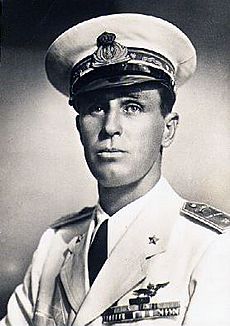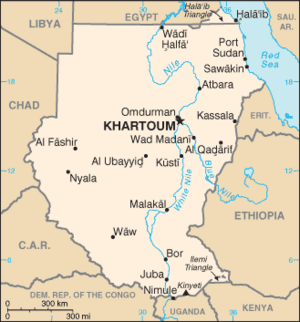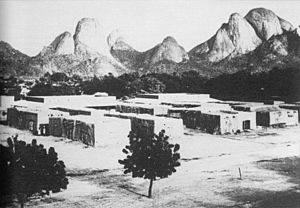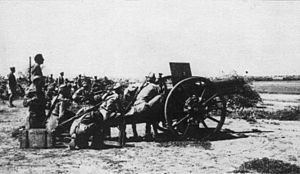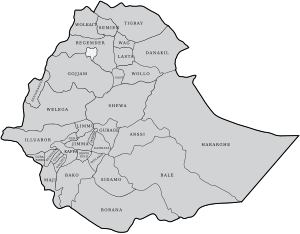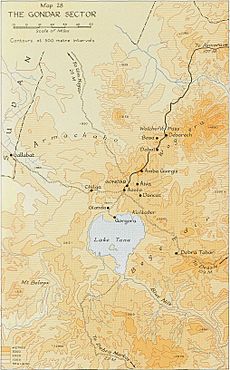Northern front, East Africa, 1940 facts for kids
Quick facts for kids Northern front, East Africa, 1940 |
|||||||
|---|---|---|---|---|---|---|---|
| Part of East African Campaign (World War II) | |||||||
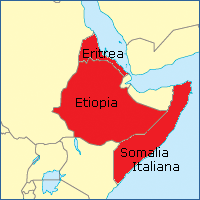 Italian East Africa (Africa Orientale Italiana) 1940 |
|||||||
|
|||||||
| Belligerents | |||||||
| Commanders and leaders | |||||||
| William Platt | Luigi Frusci | ||||||
| Units involved | |||||||
| Sudan Defence Force Northern Rhodesia Regiment |
Comando Forze Armate dell'Africa Orientale Italiana | ||||||
The Northern Front in East Africa was a series of battles during the Second World War in 1940. These fights took place between British forces in Sudan and the Italian army in Eritrea and Ethiopia.
In June 1940, Italy had a large army in Italian East Africa (AOI), with over 290,000 soldiers. By August, this number grew to over 370,000. The British commander, General Archibald Wavell, had about 86,000 troops spread across many areas, including East Africa.
Fighting began on June 10, 1940, when Italy declared war. Italian forces quickly captured key towns like Kassala and Gallabat in Sudan. They also took Karora and Kurmuk. The British worried about an Italian attack on Khartoum, the capital of Sudan. However, the Italians mostly stayed in their captured areas and did not advance further.
In August, Italy invaded British Somaliland. British forces slowly retreated and were evacuated by sea. This made British Prime Minister Winston Churchill unhappy with General Wavell. The British also decided to support Haile Selassie, the former emperor of Ethiopia, who had been overthrown by Italy. Secret British groups worked from Sudan to cause trouble for the Italians in Ethiopia.
The British blocked supplies to Italian East Africa, making it hard for the Italians to get fuel and ammunition. The Italians waited, hoping Germany would defeat Britain soon. They also waited for their invasion of Egypt to succeed before attacking Sudan.
The British, with new troops from India and Egypt, planned to invade Eritrea in February 1941. But the Italians surprised them by retreating from Kassala in January. The British quickly followed, invading Eritrea and winning the Battle of Agordat. This victory began the British takeover of Eritrea. Haile Selassie returned to Ethiopia in January 1941.
Contents
Background to the Conflict
Italian East Africa's Role
On May 9, 1936, Italy's leader, Benito Mussolini, created Italian East Africa (AOI). This new territory included the Italian colonies of Eritrea and Somaliland, plus Ethiopia, which Italy had recently conquered.
Amedeo, Duke of Aosta, became the leader of AOI in November 1937. His headquarters were in Addis Ababa, Ethiopia's capital. By June 1940, Aosta commanded about 290,000 Italian and local soldiers, sailors, and airmen in AOI. This number grew to over 371,000 by August.
In March 1940, Mussolini planned to defend AOI. He also wanted to launch small attacks on Sudan and a larger one on French Somaliland. Italy's air force, the Regia Aeronautica, was to support these operations. When Italy declared war on Britain and France on June 10, 1940, AOI became a threat to British and French colonies in East Africa. This also put British supply routes in the Red Sea and Suez Canal in danger.
British Forces in the Middle East
In mid-1939, General Archibald Wavell became the commander of the new Middle East Command. He had about 86,000 troops for areas like Libya, Iraq, Syria, Iran, and East Africa. About 9,000 of these troops were in Sudan.
Since 1938, Major-General William Platt led the Sudan Defence Force (SDF). He was in charge of defending Sudan, which shared a 1,000-mile border with Ethiopia. In May 1940, the British learned that Italian forces in AOI were secretly getting ready for war. The British expected Italian attacks on Khartoum, Atbara, and Port Sudan if they invaded Sudan. The land was dry and had few good roads, but it was easy to drive across during the dry season.
Secret Intelligence: Ultra
By late 1940, British code-breakers in England and Cairo managed to crack Italian army and air force secret codes. This meant the British knew a lot about Italian troop movements and supplies. They often received Italian messages even before the Italian commanders did. This secret information gave the British a big advantage when their attack began in January 1941.
Preparing for Battle
Sudan's Defences
In 1940, Britain had three infantry battalions in Sudan. The SDF had 4,500 men in 21 companies, including Motor Machine-Gun companies with light machine-guns on vehicles. The Sudan Horse was training to use mountain guns.
British troops were stationed in Khartoum, Atbara, and Port Sudan. The SDF guarded the border with local police and irregular scouts. Their job was to watch, bother, and slow down any Italian advance. If the Italians invaded, British units would gather to fight them. They planned to use the long distances and poor roads to make it hard for the Italians to move supplies.
The Royal Air Force (RAF) had three bomber squadrons and some fighter planes near Port Sudan. These planes were good for protecting the Red Sea but were far from Kassala and Gedaref. In August, the RAF formed 203 Group in Khartoum to protect air routes from West Africa.
Kassala: A Key Border Town
Kassala was a town of about 25,000 people, 20 miles from the border. It was on the Mareb/Gash River and the Sudan Railway. The river flowed for about three months a year, making the land very fertile for cotton. The Italians had built a road from Asmara, Eritrea's capital, to the border. This road was a clear path for attacks in either direction. In July, the British saw Italian troops gathering near Tessenei, 12 miles inside Eritrea.
At Kassala, the British had fewer than 500 men from the SDF and local police. After Italy declared war, the Regia Aeronautica bombed Kassala and other towns. These bombings caused no military damage but scared civilians. The SDF often patrolled and raided across the border, causing some Italian casualties. The Italians remained quiet in June but prepared to attack several towns in July.
Italian Military Plans
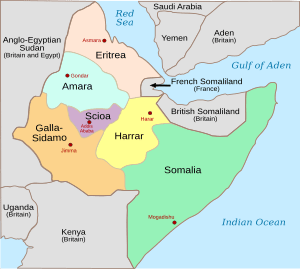
Before the war, Mussolini wanted a defensive plan for Italian East Africa. He planned small attacks to protect Eritrea and Sudan. The Italian army in AOI had one main division and two more European-style divisions, but they lacked heavy weapons and transport. They also had seven smaller colonial divisions.
The army was divided into four commands:
- Northern Sector: Near Asmara, Eritrea, led by Lieutenant-General Luigi Frusci.
- Southern Sector: In the Galla-Sidamo Governorate, led by General Pietro Gazzera.
- Eastern Sector: On the border with French and British Somaliland, led by General Guglielmo Nasi.
- Giuba Sector: In southern Somalia, led by Lieutenant-General Carlo De Simone.
The Regia Aeronautica had 325 aircraft in AOI, but many were not ready to fly. They also had little chance of getting more fuel or spare parts. For the attack on Kassala, the Italians gathered two colonial brigades, four cavalry squadrons, about 24 light and medium tanks, armored cars, and ten artillery batteries.
Key Operations and Battles
The Capture of Kassala
The Italian attack on Kassala began at 3:00 a.m. on July 4, 1940. About 6,500 Italian and colonial troops attacked in three groups, supported by the Regia Aeronautica and cavalry.
Kassala was defended by fewer than 500 SDF and local police. They stayed hidden during a 12-hour bombing by Italian planes. When they came out, they destroyed six Italian tanks and caused many casualties. At 1:00 p.m., Italian cavalry entered Kassala. The defenders pulled back, losing one killed, three wounded, and 26 missing. The Italians lost 43 killed and 114 wounded. The same day, the Italians also captured Gallabat and Kurmuk in Sudan.
At Kassala, the Italians built strong defenses. They were surprised that the local Sudanese people still supported the British. The SDF continued to operate near Kassala. The British spread rumors that they had many more troops on the border than they actually did. This made the Italians think twice about advancing. In August, the 5th Indian Infantry Division arrived in Sudan to help.
Gazelle Force's Raids
In September 1940, the 5th Indian Infantry Division arrived in Sudan. General Platt used a special unit called Gazelle Force, led by Colonel Frank Messervy. This force was made up of cavalry, machine-gun units, and artillery. Their job was to scout ahead, bother the Italians, and make them think the British had a much larger army. The British even used the word "Five" instead of "5th" in their messages to trick Italian spies into believing there were five Indian divisions.
After a British attack on Gallabat failed in November, Gazelle Force continued to raid Italian outposts near Kassala. These raids made the Italian commander, Aosta, order his northern sector commander, Frusci, to stop the British. Two Italian battalions tried to fight Gazelle Force for two weeks but then pulled back.
By January 1941, the Italians started to reduce their troops on the Sudan border. News of a big British victory in Egypt, along with Gazelle Force's raids, made Frusci worried. On January 17, the Italian 12th Colonial Brigade pulled back from Kassala and Tessenei.
Italian Invasion of British Somaliland
In 1940, British Somaliland had a small force of 631 soldiers and some police. The British hoped that invading this area would be too difficult for the Italians. However, after France surrendered in 1940, the British in Somaliland were left alone.
On August 3, 1940, the Italians invaded with two colonial brigades, four cavalry squadrons, 24 medium tanks, armored cars, 21 artillery batteries, and air support. The British forces fought small battles as they slowly retreated. By August 11, Major-General Alfred Reade Godwin-Austen took command. British forces grew to five battalions, about 4,500 troops.
The main British defense was at the Tug Argan Gap, which controlled the road to Berbera. The Battle of Tug Argan began on August 11. By August 14, the British were almost surrounded. The next day, Godwin-Austen got permission to leave the colony. By August 18, most British and local troops were evacuated to Aden. The Italians entered Berbera on August 19. The British lost 38 killed and 222 wounded. The Italians had 2,052 casualties and used up valuable supplies. Churchill criticized Wavell for giving up the colony, but Wavell called it a good retreat against stronger forces.
The Battle for Gallabat
Gallabat fort was in Sudan, about 200 miles south of Kassala, across the border from Metemma in Ethiopia. Both places had strong defenses. Gallabat was held by an Italian colonial infantry battalion. Metemma had two colonial battalions.
On November 6, at 5:30 a.m., the British 10th Indian Infantry Brigade, with artillery and tanks, attacked Gallabat. Six British bombers and nine fighter planes were supposed to clear the sky of Italian planes. The British infantry gathered near Gallabat, surprising the Italian defenders. The RAF bombed the fort, knocking out its radio. British artillery then shelled Gallabat and Metemma.
Indian soldiers reached Gallabat and fought hand-to-hand with Italian and Eritrean troops inside the fort. Italian forces counter-attacked, but the British pushed them back. However, three British tanks were destroyed by mines, and six broke down on the rocky ground. Italian planes attacked all day, shooting down seven British fighters and destroying a truck with tank spare parts. The ground was too hard to dig trenches, leaving the British infantry exposed to bombing.
During the battle, some British troops panicked and ran away. The Italian bombers returned the next morning. That evening, the British commander ordered a retreat from Gallabat Ridge. British engineers stayed behind to destroy buildings and supplies in the fort. British casualties were 42 killed and 125 wounded. The Italians were thought to have lost about 600 men.
The British continued to patrol the area to prevent the Italians from re-occupying the fort. On November 9, two Indian companies attacked and held the fort during the day, then left. An Italian counter-attack that night was stopped by artillery fire. The next morning, the British re-occupied the fort without a fight. The British used tricks to make the Italians believe that their main attack would be towards Gondar in the south, not Kassala in Eritrea.
Aftermath of the Northern Front
Battle Losses
At Kassala, the British lost one soldier killed, three wounded, and 26 missing. The Italians had 43 killed and 114 wounded. During the invasion of British Somaliland, the British lost 38 killed and 222 wounded. The Italians suffered 2,052 casualties and used up valuable fuel and ammunition. In the fighting at Gallabat in November, the British lost 42 killed and 125 wounded. Italian losses were estimated at around 600 men.
Next Steps in the Campaign
After the British setback at Gallabat, General Wavell reviewed the situation in December. With a major British attack planned in Egypt, the forces in East Africa were to help Ethiopian fighters and keep pressure on the Italians at Gallabat. Kassala was to be recaptured in early January 1941.
After a big British victory in Egypt, East Africa became the second most important area. The goal was to defeat the Italian forces in Ethiopia by April. The Italian retreat from Kassala on January 18, 1941, showed that the British victory in Egypt was affecting the situation in East Africa. The British attack from Sudan, planned for February 9, was moved up to January 19.
General Platt was ordered to chase the Italians. He fought the Battle of Agordat from January 26 to 31, 1941, capturing Agordat on February 1 and Barentu the next day. Haile Selassie, the former Emperor of Ethiopia, returned to Ethiopia on January 20. British-supported Ethiopian irregulars, known as the Arbegnoch (Patriots), attacked Italian roads to keep Italian troops busy defending Addis Ababa.
See also
- List of British military equipment of World War II
- List of Italian Army equipment in World War II


